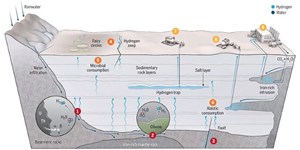News
NREL selected as part of $1.6 MM in federal funding to explore potential of geologic H2
The National Renewable Energy Laboratory (NREL) was recently selected as one of 16 teams to research enhanced production of geologic H2 by the U.S. Department of Energy (DOE) Advanced Research Projects Agency-Energy (ARPA-E) program.
Led by Texas Tech University with partners from NREL, Lawrence Berkeley National Laboratory, Rio Tinto, and Lavoisier H2 Geoconsult, this project aims to stimulate H2 production from iron-rich mafic and ultramafic rocks via chemical, mechanical and biological processes.
Geologic H2 is a poorly understood but potentially groundbreaking energy resource involving certain types of rocks and subsurface environments that produce natural H2. ARPA-E is leading first-of-its-kind federal funding efforts to evaluate ways to stimulate H2 production (enhance or increase the natural rates) from geologic resources. Clean H2, including naturally occurring subsurface H2, can sustainably reduce harmful emissions from some of the most energy-intensive sectors of the economy, such as chemical and industrial processes and heavy-duty transportation.
The project will produce valuable scientific research to understand the opportunities this resource presents via a first-of-its-kind research grant on geologic H2 stimulation technologies.
"Natural H2 production is important because current methods for producing H2 are energy intensive, with H2 needing to be derived from other sources, like water or methane," said Dayo Akindipe, an NREL research scientist in the Center for Energy Conversion and Storage Systems. "This new process intends to accelerate the production of natural H2 by applying multiple stimulation methods to produce H2 that can be used for transportation, chemical and industrial processes, and other applications. This research will allow NREL to enable another clean H2 pathway."
Led by Akindipe, NREL will support this new project by implementing a microcosm experiment to characterize the rock, water, and H2 system. NREL researchers Katherine Chou and Jianping Yu will look at ways to inhibit the microbial uptake of the produced H2 and see how biocatalysts can help to increase the rate of H2 production. NREL's team will also assist in developing tech-to-market efforts once they have established the viability of the geologic H2 system.
Akindipe, who has a background in chemical and petroleum engineering, began his career working in the oil and gas industry before coming to NREL. For him, this project merges both his experience and his passion for sustainable energy.
"This ties into my own personal energy transition," he said. "I became even more active in the space of geologic H2 because I saw it was a niche area—not just at NREL, but for the entire country. It's an area that the U.S. can tap into that will positively transform the energy space and society."
The funding is part of ARPA-E's Exploratory Topics related to geologic H2, which aim to explore early-stage research and development to advance low-cost, low-emissions H2. This is the first time that the U.S. government has competitively selected teams to research this kind of technology. This energy resource would potentially produce no carbon emissions when burned or used in a fuel cell and will support efforts to reduce costs and enable commercial-scale deployment of clean H2.
The teams selected will explore early-stage research and development to advance low-cost, low-emissions H2, which will help create good-paying jobs and new economic opportunities in communities across the nation while also helping meet climate and decarbonization goals.
"This project is going to tell us a couple of things," Akindipe said. "Firstly, is geologic H2 production possible at scale? Secondly, will it be feasible economically and in terms of life cycle emissions? These are the questions this project will answer."


